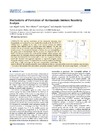Please use this identifier to cite or link to this item:
https://accedacris.ulpgc.es/jspui/handle/10553/74807
| DC Field | Value | Language |
|---|---|---|
| dc.contributor.author | Azofra Mesa, Luis Miguel | en_US |
| dc.contributor.author | Alkorta, Ibon | en_US |
| dc.contributor.author | Elguero, José | en_US |
| dc.contributor.author | Toro-Labbé, Alejandro | en_US |
| dc.date.accessioned | 2020-10-16T14:07:30Z | - |
| dc.date.available | 2020-10-16T14:07:30Z | - |
| dc.date.issued | 2012 | en_US |
| dc.identifier.issn | 1089-5639 | en_US |
| dc.identifier.uri | https://accedacris.ulpgc.es/handle/10553/74807 | - |
| dc.description.abstract | The reaction mechanism of the hemiacetal formation from formaldehyde and methanol has been studied theoretically at the B3LYP/6-311+ +G(d,p) level. In addition to the study of the reaction between the isolated reactants, three different kinds of catalysis have been explored. The first one examines the use of assistants, especially bridging water molecules, in the proton transfer process. The second one attempts to increase the local electrophilicity of the carbon atom in formaldehyde with the presence of a Brønsted acid (H+ or H3O+ ). The last one considers the combined effect of both catalytic strategies. The reaction force, the electronic chemical potential, and the reaction electronic flux have been characterized for the reaction path in each case. In general, it has been found that structural rearrangements represent an important energetic penalty during the activation process. The barriers for the reactions catalyzed by Brønsted acids show a high percentage of electronic reorganization contribution. The catalytic effects for the reactions assisted by water molecules are due to a reduction of the strain in the transition state structures. The reaction that includes both acid catalysis and proton assistance transfer shows the lowest energy barrier (25.0 kJ mol−1 ). | en_US |
| dc.language | eng | en_US |
| dc.relation.ispartof | Journal of Physical Chemistry A | en_US |
| dc.source | Journal of Physical Chemistry A [ISSN 1089-5639], 116, p. 8250−8259 | en_US |
| dc.subject | 2307 Química física | en_US |
| dc.title | Mechanisms of Formation of Hemiacetals: Intrinsic Reactivity Analysis | en_US |
| dc.type | info:eu-repo/semantics/article | en_US |
| dc.type | Article | en_US |
| dc.identifier.doi | 10.1021/jp304495f | en_US |
| dc.description.lastpage | 8259 | en_US |
| dc.identifier.issue | 31 | - |
| dc.description.firstpage | 8250 | en_US |
| dc.relation.volume | 116 | en_US |
| dc.investigacion | Ciencias | en_US |
| dc.type2 | Artículo | en_US |
| dc.description.numberofpages | 10 | en_US |
| dc.utils.revision | Sí | en_US |
| dc.identifier.ulpgc | No | en_US |
| dc.description.sjr | 1,494 | |
| dc.description.jcr | 2,771 | |
| dc.description.sjrq | Q2 | |
| dc.description.jcrq | Q2 | |
| dc.description.scie | SCIE | |
| item.grantfulltext | open | - |
| item.fulltext | Con texto completo | - |
| crisitem.author.dept | GIR IUNAT: Fotocatálisis y espectroscopía para aplicaciones medioambientales. | - |
| crisitem.author.dept | IU de Estudios Ambientales y Recursos Naturales | - |
| crisitem.author.orcid | 0000-0003-4974-1670 | - |
| crisitem.author.parentorg | IU de Estudios Ambientales y Recursos Naturales | - |
| crisitem.author.fullName | Azofra Mesa, Luis Miguel | - |
| Appears in Collections: | Artículos | |
WEB OF SCIENCETM
Citations
34
checked on Jun 8, 2025
Page view(s)
276
checked on Mar 15, 2025
Download(s)
784
checked on Mar 15, 2025
Google ScholarTM
Check
Altmetric
Share
Export metadata
Items in accedaCRIS are protected by copyright, with all rights reserved, unless otherwise indicated.
